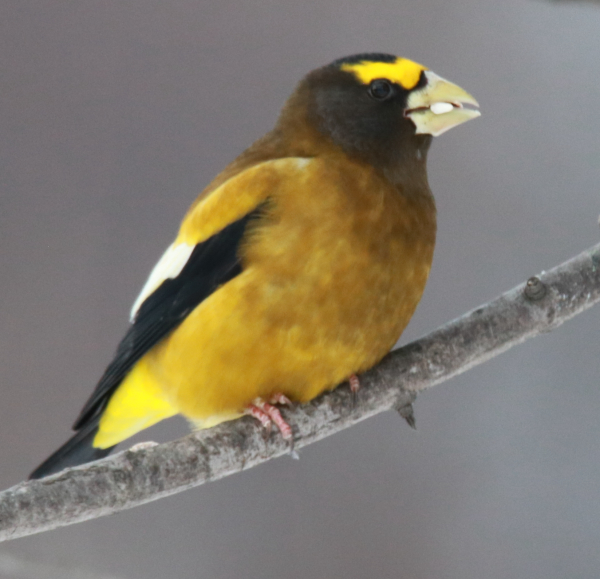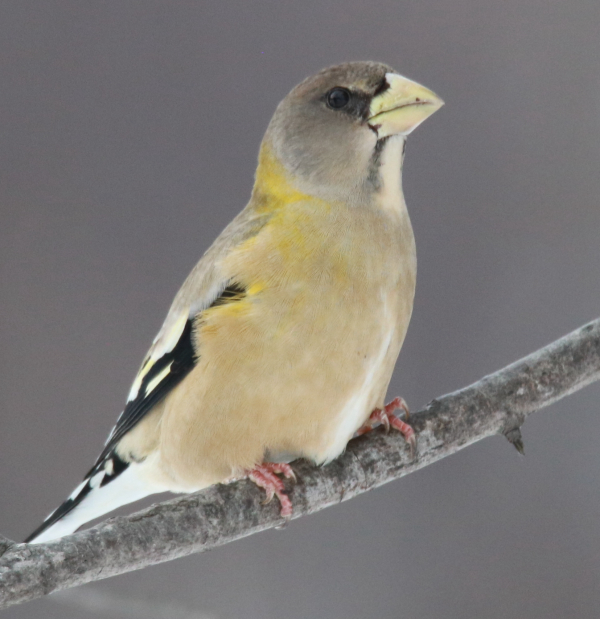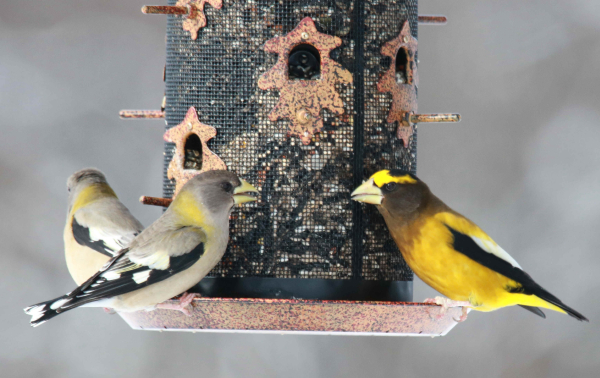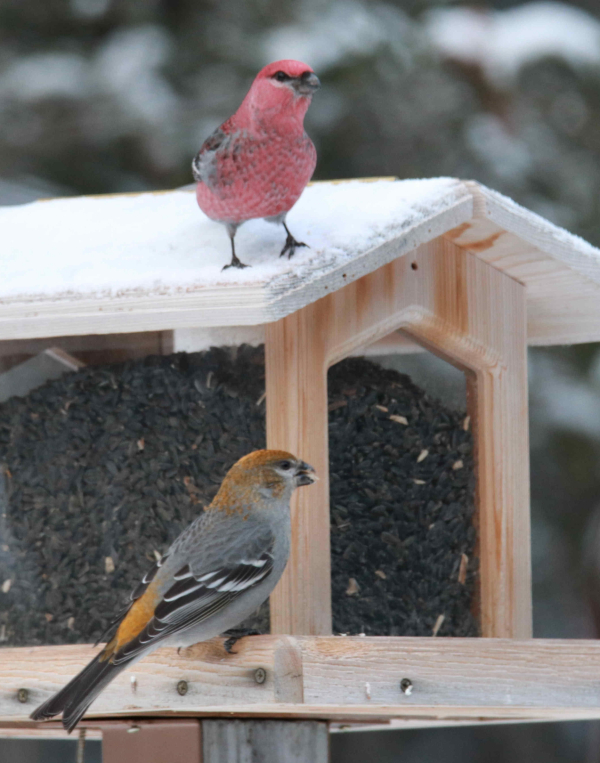
Evening Grosbeaks are especially captivating and the different plumages of a male (above) and female (below) provide an added attraction for birders.


Close observations of many species would not have been possible without the generous access provided by area landowners.

Pine Grosbeaks are a special species that are among the most impressive of Northwoods birds. Like Evening Grosbeaks, males and females have distinctive plumages; the male is positioned above the female on this snow-covered feeder.
|
Deep in Minnesota’s Northwoods there is a most impressive organized effort to provide feeders for wintering birds that migrate from Canada and the surrounding area, including some of the fabled northern finches. At the infamous Sax-Zim Bog, it is now possible to visit a variety of public-access feeding stations provided in local landowner’s yards, at the head of some hiking trails, and at the Sax-Zim Bog Welcome Center. Collectively, these feeding stations are attracting Evening Grosbeaks, Pine Grosbeaks, Common Redpolls, Red-breasted Nuthatches, Boreal Chickadees, and Canada Jays – exciting winter feeder birds indeed!
With visions of Great Gray Owls and Pine Grosbeaks in mind, and hopes of taking photos of some of the wintering birds including an impressive variety of feeder visitors, I drove far east of my Great Plains abode, following a light snowstorm to the Sax-Zim Bog. This wild slice of wilderness woodlands is dominated by tamarack and black spruce with stands of aspen and birch trees, with a sprinkling of private lands located about an hour northwest of Duluth.
Since my last visit 13 years ago (gee, has it been that long?), birding has become much more organized with the advance of the “Friends of the Sax-Zim Bog” a dozen years ago. And now, bird feeding stations have become more prevalent and accessible, providing an interesting opportunity to literally make a tour of the region driving from feeding station to feeding station, with plenty of prime Bog habitat along each roadway to search for other exciting birds.
I visited many of the public-access feeding stations, but had the best results at 3 popular locations: 1) The feeders at the Welcome Center, which attracted periodic flocks of about 10 Pine Grosbeaks along with Common Redpolls, Hairy and Downy Woodpeckers, and Black-capped Chickadees. 2) The dozen feeders and heated birdbath at Lou’s Feeders, which attracted up to 30 Evening Grosbeaks at a time, adding a lot of color and action to the yard that hosted a Red-bellied Woodpecker, Downy and Hairy Woodpeckers, Blue Jays, Red-breasted Nuthatches, and Black-capped Chickadees. 3) The Admiral Road Feeders, where at least 3 Canada Jays visited along with Hairy and Downy Woodpeckers, and Black-capped Chickadees. This feeding station is considered one of the best locations to see Boreal Chickadees in Minnesota, but I missed that species during this trip.
Timing probably plays an important part of the amount of bird activity at the feeding stations. I visited each of the above locations twice, and while the action at the first 2 were similar during both visits, the third feeding station only had a couple chickadees during my afternoon visit, even though the site was very busy in the morning. This may have been the case at some of the other feeding stations I visited during the afternoon, and some of them certainly looked promising, especially the Sisu Feeders and the Winterberry Bog Feeders. That said, birds are not always predictable, so it’s worth checking as many feeding stations as possible to see what you might find. It is also important to note that the feeding stations are fairly spread out and often miles apart across the expansive Sax-Zim Bog.
A Peanut Butter Feeder
Black-oil sunflower seeds in the shell were the dominant foods being offered, along with suet and thistle seeds, while there was a rather unique feeder among Lou’s feeders. There, the peanut butter feeder was new to me, and it consisted of a gallon jar of peanut butter positioned horizontally on a 3-sided wooden frame that had a short horizontal extension on the bottom of the frame that provided a perch for woodpeckers and other birds to stand on as they reached their bill into the big open plastic jar of peanut butter.
In this article, I wanted to provide an example of how feeding stations can be an exciting stop for birders, and you may be aware of local nature centers that provide public access to their feeders that may become important sites for you to visit periodically. At most nature centers and in the Sax-Zim Bog region there are also hiking trails that may be of interest to you to get some outdoor exercise as you search for birds in the area.
At the same time, I wanted to share some of the exciting birds I spent time with during one of my holiday outings. There is no doubt that the 2 species of grosbeaks provided the best feeder highlights, and this was the first time I had extended opportunities to observe, listen to, and photograph Pine Grosbeaks and Evening Grosbeaks. I must admit that these birds were magnetic and it was great fun to get to know them better at the feeding stations.
I also wanted to point out what a great effort the Friends of the Sax-Zim Bog have been making to gain the interest and participation of many local residents who generously welcome birders to view and photograph birds on their properties and in their yards. Likewise, the Friends have provided a central point for birders to visit by constructing the Welcome Center, its feeders, and hiking trail, while providing excellent information sources including birding maps of the Bog and online information.
To learn more about the Sax-Zim Bog and view a map of the region that includes the location of public-access feeding stations, you can refer to Friends of Sax-Zim Bog (saxzim.org)
Article and photos by Paul Konrad
Share your backyard birding experiences and photos at editorstbw2@gmail.com